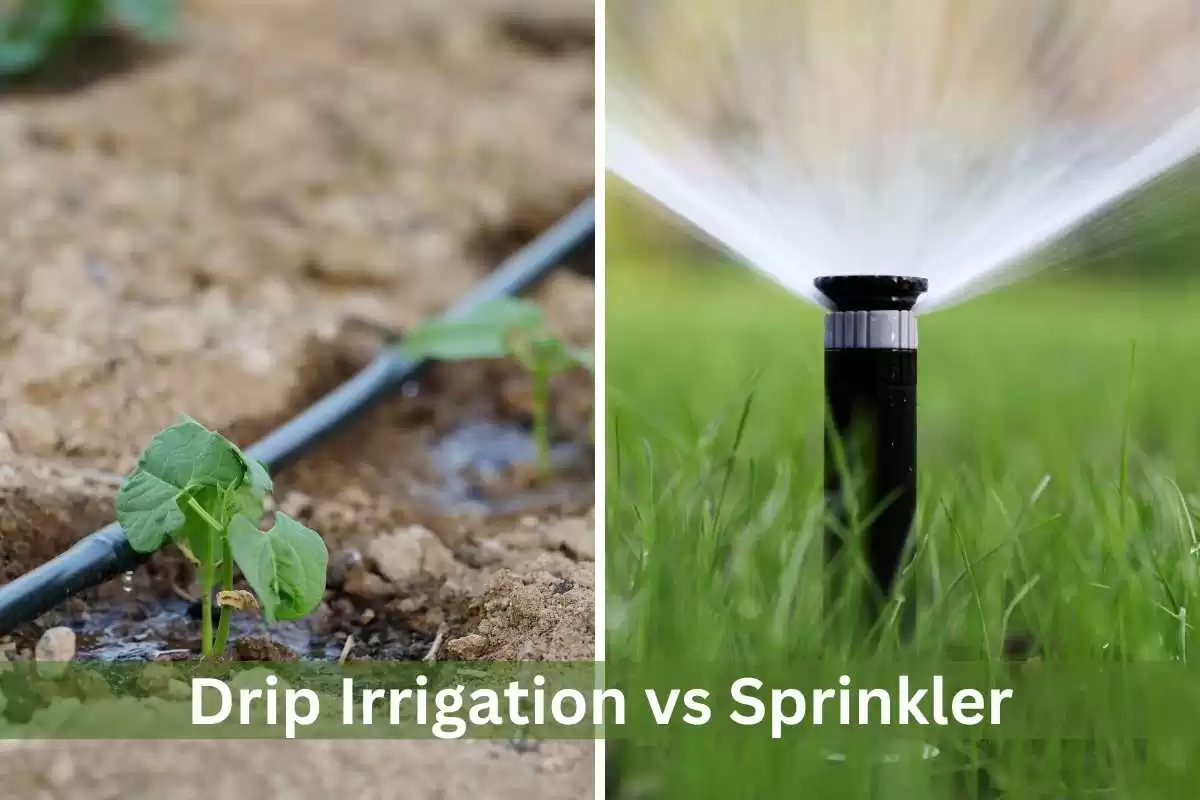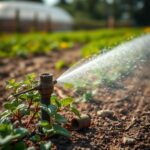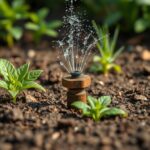What's the Difference Between Irrigation and Sprinklers? A Comprehensive Guide to Watering Methods

Irrigation systems and sprinklers are two popular methods used for watering gardens, lawns, and agricultural fields. While they both serve the fundamental purpose of delivering water to plants, the techniques and applications can vary significantly. Understanding the differences between irrigation and sprinkler systems is essential for optimizing water usage, ensuring plant health, and promoting sustainability. This comprehensive guide will delve into the various types of irrigation methods, the mechanics of sprinkler systems, and the advantages and disadvantages of each approach. By the end, readers will be better equipped to choose the most suitable watering method for their specific needs.
Differences Between Irrigation and Sprinklers
Irrigation refers to the controlled application of water to plants to help them grow, while sprinklers are a specific type of irrigation system that distributes water in a spray format over a designated area. The main difference lies in the method of water delivery: irrigation can include a variety of techniques such as drip, surface, and subsurface systems, whereas sprinklers operate by spraying water in a pattern from above, mimicking natural rainfall. Furthermore, irrigation systems can be designed for larger agricultural fields or smaller gardens, and they can utilize different water sources, including reservoirs and groundwater. In contrast, sprinkler systems are often used for lawns, gardens, and sports fields, providing a more uniform water coverage.
Types of Irrigation Systems
There are several types of irrigation systems designed to optimize water usage for various applications. The most common types include drip irrigation, which delivers water directly to the roots of the plants through a network of tubing and emitters; surface irrigation, where water is distributed over the soil surface; and subsurface irrigation, which involves burying the irrigation lines beneath the soil. These systems can cater to diverse agricultural needs, making irrigation a versatile solution for watering crops and landscapes.
How Sprinkler Systems Work
Sprinkler systems operate by utilizing a network of pipes, valves, and spray heads to distribute water across a designated area in a controlled manner. The pressurized water flows through the network and is atomized into droplets by sprinkler heads, which can be adjustable to cover various radius ranges. This method effectively mimics rainfall, ensuring even water distribution and helping to maintain healthy vegetation. The flexibility and programmability of sprinklers allow for tailored watering schedules based on specific plant requirements.
Water Efficiency
Water efficiency is a crucial consideration in irrigation and sprinkler systems. Drip irrigation is often regarded as one of the most water-efficient methods because it minimizes evaporation and runoff by directing water straight to plant roots. In contrast, traditional sprinkler systems may experience water loss through evaporation when used during hot weather or high winds. Adopting efficient systems is important for conserving water resources, particularly in regions facing drought conditions.
Cost Considerations
The cost of implementing and maintaining irrigation and sprinkler systems can vary significantly. Drip irrigation often has higher initial costs due to the complexity of installation and necessary components. However, it can lead to savings on water bills and improved crop yield in the long run. Sprinkler systems, while typically less expensive to install, may incur higher water costs if not properly managed. Homeowners and farmers must evaluate their budget and long-term goals when choosing between these systems.
Common Applications
Both irrigation and sprinkler systems have specific applications depending on the requirements of the landscape or agricultural setting. Irrigation systems are commonly used in large-scale agriculture, where precise water delivery is essential for crop health. Sprinklers are favored for residential lawns, parks, and sports fields due to their ease of use and wider coverage. Understanding the intended use of each system can help homeowners and farmers make informed choices that align with their water management strategies.
| Feature | Irrigation Systems | Sprinkler Systems |
|---|---|---|
| Water Delivery Method | Variety of techniques (e.g., drip, surface) | Spraying water from above |
| Water Efficiency | High, especially drip systems | Variable, can be less efficient |
| Installation Cost | Can be higher for complex setups | Typically lower initial costs |
| Common Uses | Agricultural fields, gardens | Lawn, parks, sports fields |
Is sprinkler and irrigation the same thing?

The terms sprinkler and irrigation are often used interchangeably, but they refer to different concepts within the realm of agricultural and landscape watering systems. Understanding the distinction between the two is essential for anyone involved in gardening, farming, or landscape management.
Understanding Irrigation
Irrigation is a broader term that encompasses various methods and systems used to supply water to crops or plants. Its primary objective is to enhance plant growth by ensuring adequate moisture in the soil.
- Methods: There are several methods of irrigation, including surface irrigation, drip irrigation, and sprinkler irrigation.
- Purpose: Irrigation is often utilized for agricultural purposes, landscaping, and maintaining gardens.
- Efficiency: Different methods of irrigation have varied efficiency levels, impacting water usage and crop yield.
What is a Sprinkler?
A sprinkler is a specific type of irrigation system that distributes water in the form of droplets, simulating natural rainfall. Sprinklers can be stationary or mobile and are commonly used in residential and commercial settings.
- Types: There are different types of sprinklers, such as stationary, oscillating, and rotating sprinklers.
- Components: Most sprinkler systems consist of a water supply, piping, pump, and the sprinkler heads themselves.
- Applications: Sprinklers are widely used for watering lawns, gardens, and sports fields.
Differences Between Sprinkler and Irrigation Systems
While sprinklers are a part of the irrigation family, they represent only one method of watering. The fundamental difference lies in their scope and application.
See also:
- Scope: Irrigation encompasses all methods of delivering water, while sprinklers are just one way to achieve this.
- Use Cases: Irrigation can use various techniques, but sprinklers specifically focus on distributing water above ground.
- Water Flow: Sprinklers disperse water over a larger area, whereas other irrigation methods may deliver water directly to the root zone.
Benefits of Using Sprinklers in Irrigation
Sprinklers offer several advantages that make them a popular choice for many landscaping and agricultural applications.
- Versatility: Sprinklers can be adjusted for different areas, making them suitable for various garden sizes.
- Ease of Use: They require less manual labor compared to other irrigation methods.
- Uniform Coverage: Sprinkler systems can provide even water distribution, which is crucial for healthy plant growth.
Choosing the Right Irrigation System
Selecting the appropriate irrigation system depends on multiple factors including plant needs, climate, and water availability.
- Plant Type: Different plants require various amounts of water; some may thrive better with drip systems instead of sprinklers.
- Soil Type: Understanding soil absorption can help determine whether sprinklers or other methods are more efficient.
- Water Sources: Availability of water resources will influence the choice of irrigation method.
Is a sprinkler a method of irrigation?

Yes, a sprinkler is indeed a method of irrigation. It refers to a system that distributes water to crops or plants through a series of nozzles that spray water in the form of droplets, mimicking natural rainfall. This method can be particularly effective for irrigating large areas and is commonly used in both agriculture and landscape gardening. Sprinkler systems can be stationary or moveable and can cover various areas, depending on their design and capacity.
Advantages of Sprinkler Irrigation
Sprinkler irrigation offers several benefits that make it a popular choice among farmers and gardeners.
- Efficient Water Use: Sprinklers can provide precise water application, minimizing waste.
- Wide Coverage: They can cover large fields or gardens, making them suitable for various landscapes.
- Reduction of Soil Erosion: By applying water slowly, sprinklers help prevent soil displacement.
Types of Sprinkler Systems
There are various types of sprinkler systems, each designed for specific needs and settings.
- Stationary Sprinklers: These remain in one position and water a fixed area.
- Rotary Sprinklers: These rotate to cover a larger radius, making them versatile for uneven terrain.
- Impact Sprinklers: They use a mechanism to create a spray through physical movement, often used in agricultural applications.
Components of a Sprinkler System
A typical sprinkler system consists of several components that work together to distribute water efficiently.
- Pipes: These transport water from the source to the sprinklers.
- Valves: Used to control the flow and pressure of water.
- Sprinkler Heads: The actual emitters that disperse water onto the plants.
Applications of Sprinkler Irrigation
Sprinkler irrigation is used in various applications, each tailored to meet specific watering needs.
- Agricultural Fields: Frequently employed in large-scale farming to ensure even water distribution.
- Residential Gardens: Homeowners often use sprinklers for lawn care and garden maintenance.
- Parks and Recreational Areas: Keep public green spaces lush and healthy through regular watering.
Challenges of Using Sprinkler Irrigation
While sprinkler systems are beneficial, they also come with some challenges that need to be addressed.
- Inconsistent Coverage: Areas may receive different amounts of water, leading to uneven growth.
- Wind Interference: Wind can cause water to drift away from the intended area.
- Initial Costs: Setting up a sprinkler system can be expensive, especially for large areas.
Which is better, drip irrigation or sprinkler system?

Cost Comparison
Drip irrigation systems typically have a higher initial cost than sprinkler systems due to the materials and installation requirements. However, over time, drip systems can lead to significant savings in water costs and maintenance. The following points outline the cost aspects of each system:
- Initial Installation Cost: Drip irrigation generally costs more upfront because of the specialized components.
- Long-term Savings: Drip systems can reduce water usage by 30-50%, leading to lower utility bills.
- Maintenance Fees: Sprinkler systems may incur more frequent maintenance costs, especially if they are not properly managed.
Water Efficiency
When comparing water efficiency, drip irrigation systems are often deemed superior to sprinkler systems. Drip systems deliver water directly to the root zone, reducing evaporation and runoff. This targeted approach offers several advantages:
See also:
- Reduced Evaporation: Water is delivered directly to the soil, minimizing loss through evaporation.
- Targeted Watering: Roots receive water precisely where needed, promoting healthier plant growth.
- Water Conservation: Drip irrigation uses significantly less water, benefiting both the environment and the grower’s wallet.
Maintenance Requirements
Both systems require maintenance, but the type and frequency can vary considerably. Drip irrigation systems may need periodic checks for clogs, while sprinkler systems often require more ongoing adjustments and repairs. Here are some key maintenance considerations:
- Clogging Issues: Drip emitters can clog, necessitating regular inspections and cleaning.
- System Adjustments: Sprinkler heads may need continual adjustments for optimal coverage.
- Longevity: Drip systems can have a longer lifespan if properly maintained compared to traditional sprinklers.
Plant Health and Growth
The method of irrigation can significantly impact the health and growth of plants. Drip irrigation provides numerous benefits that can enhance plant performance compared to sprinklers:
- Reduced Disease Risk: By keeping foliage drier, drip systems help reduce the likelihood of disease, which often arises from wet leaves.
- Uniform Moisture Levels: Consistent moisture in the root zone promotes healthier root growth and overall plant vigor.
- Customized Watering: Drip systems allow for variable watering schedules based on plant needs, enriching growth.
Environmental Impact
Both systems have environmental implications, but drip irrigation tends to be more eco-friendly due to its efficient use of water. Consider the following environmental factors when evaluating the two systems:
- Water Conservation: Drip irrigation minimizes water waste, contributing to sustainable resource management.
- Reduction of Runoff: With targeted watering, there is less runoff and subsequent soil erosion.
- Energy Efficiency: Lower water usage translates to reduced energy consumption, particularly in regions where water pumping is energy-intensive.
What are the 4 types of irrigation?

The four main types of irrigation are surface irrigation, drip irrigation, sprinkler irrigation, and subsurface irrigation. Each method has its unique characteristics and applications, making them suitable for different agricultural practices and climates.
Surface Irrigation
Surface irrigation is one of the oldest and most widely used methods of irrigation. In this technique, water is applied directly onto the soil surface and allowed to flow over the field by gravity.
- Method of Application: Water is distributed over the soil surface either via furrows or basin methods.
- Efficiency: This method can lead to uneven water distribution and can be less efficient in terms of water usage compared to other methods.
- Soil Type Compatibility: Best suited for flat or gently sloping lands and works effectively in soil types that have good water retention.
Drip Irrigation
Drip irrigation is considered one of the most efficient irrigation methods. It delivers water directly to the root zone of plants through a system of tubes, pipes, and emitters.
- Water Savings: This method minimizes evaporation and runoff, significantly saving water.
- Soil Moisture Maintenance: It helps maintain optimal soil moisture levels without over-saturating the soil.
- Crop Suitability: Ideal for high-value crops, it allows for precise irrigation and is often used in greenhouses and orchards.
Sprinkler Irrigation
Sprinkler irrigation works by spraying water into the air through a system of pipes and fitted nozzles, resembling natural rainfall. It is versatile and can be used on various terrains.
- Distribution Uniformity: It provides more uniform water coverage compared to surface irrigation, which helps in efficient water use.
- Adaptability: Suitable for a variety of crop types and can be used on uneven terrains since it does not rely on gravitational flow.
- System Management: Requires a pump and power source which can increase operational costs, but advancements in technology have made it more feasible.
Subsurface Irrigation
Subsurface irrigation involves burying irrigation lines below the soil surface, delivering water directly to the root zone through buried tubes or pipes.
- Water Efficiency: Significantly reduces water evaporation and runoff, maximizing water use efficiency.
- Soil Health Improvement: Minimizes soil erosion and helps maintain soil structure and aeration.
- Crop Performance: Enhances plant growth and yields by ensuring consistent moisture levels are maintained for the plants' root systems.
Questions from Our Readers
What is irrigation?
Irrigation refers to the artificial application of water to soil or land to assist in the growth of crops. This method is crucial in areas where precipitation is insufficient, ensuring that plants receive the necessary moisture for optimal development.
What are sprinklers?
Sprinklers are a type of irrigation system that distributes water through a network of pipes, ultimately spraying it over a certain area, similar to natural precipitation. They are widely used in gardens, lawns, and agricultural fields to maintain moisture levels.
How do irrigation and sprinklers differ?
The primary difference between irrigation and sprinklers lies in their mechanism. While irrigation is a broader term encompassing various methods of delivering water, sprinklers specifically refer to a mechanical system that disperses water spray over soil or plants.
See also:
Can sprinklers be used as a form of irrigation?
Yes, sprinklers can be considered a form of irrigation as they provide the necessary moisture to plants. They utilize a specific technique to evenly distribute water, making them an effective choice for both residential and agricultural purposes.

If you want to read more articles like What's the Difference Between Irrigation and Sprinklers? A Comprehensive Guide to Watering Methods, we recommend you check out our Irrigation category.
Leave a Reply
Related Articles